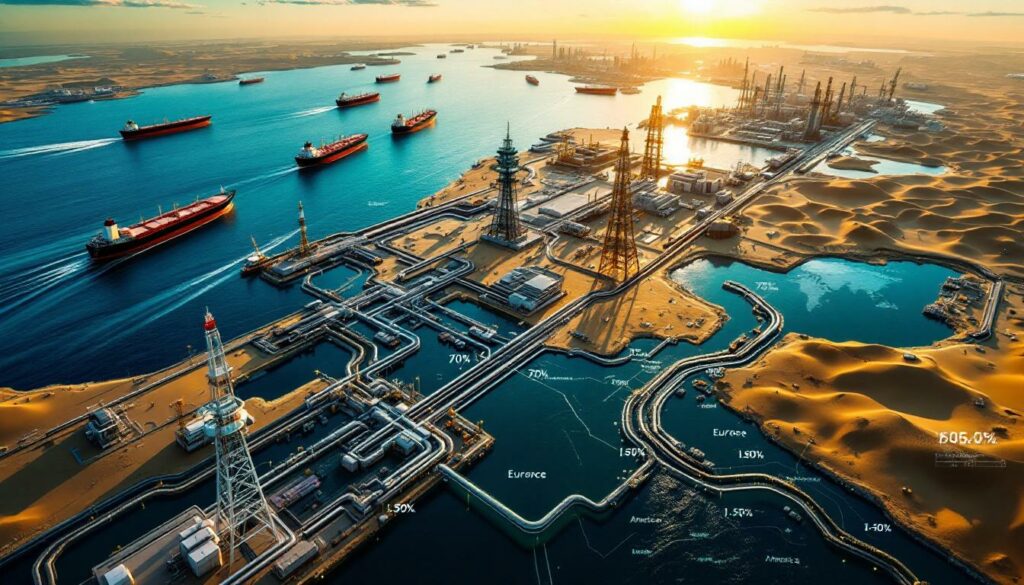How Much Oil Does Saudi Arabia Export?
Saudi Arabia maintains its position as one of the world's dominant crude oil exporters, shipping approximately 7.5 million barrels per day (bpd) as of 2025. This represents roughly one-third of the kingdom's total production capacity of 12 million bpd. Recent data from Oilprice.com shows a notable increase of 400,000 bpd in April 2025 compared to previous months, demonstrating Saudi Arabia's ability to rapidly adjust export volumes in response to market conditions.
The kingdom's export volumes serve as a critical indicator of global oil market health, with adjustments closely monitored by energy analysts worldwide. As the de facto leader of OPEC+, Saudi Arabia's export decisions ripple throughout global energy markets and contribute to OPEC production insights.
Export Volume Trends
Saudi crude exports have shown considerable volatility over the past decade, ranging from lows of 6.2 million bpd during production cuts to highs exceeding 8 million bpd during periods of market share competition. These fluctuations reflect Saudi Arabia's strategic positioning within global oil markets and its role in coordinating OPEC+ supply management.
The kingdom periodically adjusts exports based on seasonal demand patterns, with volumes typically increasing during summer months to meet peak cooling demand in importing nations. These adjustments are carefully calibrated to maintain market balance while optimizing revenue generation.
Primary Export Destinations
The geographic distribution of Saudi oil exports has evolved significantly in recent years, reflecting changing global energy consumption patterns:
- Asia-Pacific: Approximately 70% of exports, with China, Japan, South Korea, and India as primary destinations
- Europe: 15-20% of total exports, with significant volumes to Mediterranean refineries
- Americas: 5-10%, with declining volumes to the United States due to increased domestic production
- Africa and Middle East: The remaining percentage, primarily serving regional refineries
China has emerged as Saudi Arabia's largest single customer, importing approximately 1.8 million bpd of Saudi crude in recent years. This relationship has strategic importance beyond pure commercial considerations, forming part of a broader economic partnership between the two nations.
What Makes Saudi Arabia's Oil Exports Strategically Important?
Saudi Arabia's position as the world's leading crude oil exporter gives it unparalleled influence in global energy markets and international relations. The kingdom's ability to quickly adjust production volumes provides it with significant geopolitical leverage and makes it a crucial player in global energy security.
Price Stabilization Mechanism
The kingdom functions as the oil market's central bank, maintaining approximately 2 million bpd of spare production capacity that can be deployed during supply disruptions. This unique capability allows Saudi Arabia to moderate price volatility by increasing or decreasing export volumes in response to market conditions.
During major supply disruptions, such as the 2019 attacks on its Abqaiq processing facility or various geopolitical crises affecting other producers, Saudi Arabia has demonstrated its ability to rapidly increase exports to stabilize markets. This capability provides a form of "insurance" to the global economy against price shocks, though recent oil price rally dynamics have tested this stabilizing role.
"Saudi Arabia's spare capacity serves as the single most important buffer against supply disruptions in global oil markets. No other producer maintains significant idle capacity that can be brought online quickly." – International Energy Agency, Oil Market Report 2025
Economic Leverage
Saudi oil exports generate approximately 70% of government revenue and fund ambitious economic diversification initiatives under Vision 2030. The kingdom's export income supports:
- Government budgets and social services
- Sovereign wealth fund investments globally
- Domestic infrastructure development
- Military expenditures and regional security initiatives
- Economic diversification projects to reduce oil dependence
This economic reality gives Saudi export decisions significant weight in international relations, as major importing nations must consider Saudi Arabia's strategic interests when formulating their own foreign policies.
Quality Advantages
Saudi Arabian crude varieties, particularly Arab Light and Arab Medium, are highly sought after by refiners worldwide due to their:
- Consistent quality specifications with minimal batch-to-batch variation
- Moderate sulfur content (1.8-2.3%) suitable for complex refineries
- Favorable yield patterns for middle distillates like diesel and jet fuel
- Reliable supply chain infrastructure with minimal disruption history
These quality advantages give Saudi Arabia a competitive edge over many other producers whose crude requires more extensive processing or yields less valuable product slates.
How Does Saudi Arabia Manage Its Export Strategy?
The kingdom employs a sophisticated approach to maximize the value and impact of its crude exports through several key mechanisms that have evolved over decades of market experience.
Official Selling Price (OSP) System
Saudi Aramco, the state oil company, sets monthly differentials to benchmark crude prices for different regions:
- Asian buyers: Prices linked to Dubai/Oman average with adjustments reflecting regional supply/demand balances
- European customers: Brent-related pricing with modifications for Mediterranean and Northwest European markets
- American buyers: ASCI (Argus Sour Crude Index) linkage reflecting competition with regional grades
These differentials are adjusted monthly based on market conditions, refining margins, and strategic objectives, allowing Saudi Arabia to optimize revenue while maintaining market share. The OSP announcements are closely watched by oil traders as they provide insight into Saudi Arabia's market strategy.
| Region | Benchmark | Typical Premium/Discount Range |
|---|---|---|
| Asia | Dubai/Oman | +$1.00 to +$3.50 |
| Europe | Brent | -$2.00 to +$1.00 |
| USA | ASCI | -$1.00 to +$2.00 |
Strategic Infrastructure Investments
Saudi Arabia has developed extensive export infrastructure including:
- East Coast terminals at Ras Tanura and Juaymah with 6.5 million bpd capacity
- West Coast facilities at Yanbu handling 1.5 million bpd
- Strategic storage facilities in key markets including China, Japan, and the Netherlands
- Dedicated refineries in joint ventures across Asia and the United States
This infrastructure network gives Saudi Arabia flexibility in redirecting exports to capture the highest value markets while ensuring security of supply to strategic partners. Recent investments have focused on automating loading operations and enhancing cybersecurity to protect against emerging threats.
OPEC+ Coordination
As the de facto leader of OPEC+, Saudi Arabia coordinates production and export policies with other major producers, particularly Russia. This coordination extends the kingdom's influence beyond its own export volumes to shape global market dynamics.
Recent OPEC+ agreements have demonstrated Saudi Arabia's willingness to shoulder a disproportionate share of production cuts to stabilize markets during periods of oversupply, reinforcing its position as the group's central decision-maker. This leadership role amplifies the kingdom's market influence beyond what its export volumes alone would suggest.
What Challenges Does Saudi Arabia Face in Maintaining Export Dominance?
Despite its strong position, several factors threaten Saudi Arabia's long-term export strategy and require adaptations to maintain market relevance.
Energy Transition Pressures
The global shift toward decarbonization presents existential challenges to Saudi Arabia's export-driven economy:
- Peak oil demand projections ranging from 2027-2035 according to various energy agencies
- Increasing competition from renewable energy sources in electricity generation
- Carbon border adjustment mechanisms in key import markets like the European Union
- ESG investment pressures limiting capital for oil infrastructure development
Saudi policymakers are increasingly focused on maximizing export value during what may be the final decades of oil dominance in the global energy mix. This urgency has accelerated initiatives to monetize hydrocarbon reserves before potential demand declines materialize.
Regional Competition
Other producers are aggressively expanding capacity, challenging Saudi Arabia's market share:
- UAE plans to reach 5 million bpd capacity by 2027 through ADNOC's expansion program
- Iran's potential return to full export capacity following sanctions relief
- U.S. shale's resilience despite consolidation in the sector
- Growing exports from Guyana, Brazil, and other non-OPEC sources
This competition has intensified as producers race to monetize reserves before potential peak demand scenarios, creating periodic oversupply conditions that pressure Saudi export revenues and sometimes lead to an analysis of oil price crash scenarios.
Domestic Consumption Growth
Saudi Arabia faces rising internal demand for oil products:
- Power generation requirements reaching peaks of 1 million bpd during summer months
- Growing petrochemical industry feedstock needs as diversification efforts expand
- Increasing transportation fuel demand from a young, growing population
- Desalination energy requirements in a water-scarce environment
Each barrel consumed domestically represents a barrel unavailable for export, creating a strategic dilemma for policymakers seeking to balance domestic needs with export revenues.
How Is Saudi Arabia Adapting Its Export Strategy for the Future?
The kingdom is implementing a multi-faceted approach to maintain its export relevance amid energy transition challenges, focusing on securing demand and differentiating its products.
Vertical Integration
Saudi Aramco has significantly expanded its downstream investments:
- Acquired 70% stake in SABIC, the kingdom's petrochemical giant, for $69 billion
- Developed joint venture refineries in key markets to secure demand for Saudi crude
- Expanded into retail fuel operations in multiple countries including China and India
- Invested in new technologies for crude-to-chemicals conversion to capture higher value
These investments create guaranteed demand for Saudi crude exports while capturing additional value along the hydrocarbon supply chain. The strategy reduces exposure to volatile crude markets by securing stable offtake agreements with integrated operations.
Carbon Management Initiatives
To address climate concerns, Saudi Arabia is implementing:
- Carbon capture and storage projects at major production facilities targeting 11 million tons annually by 2035
- Methane emissions reduction programs across production and export infrastructure
- Low-carbon hydrogen production capabilities leveraging existing gas infrastructure
- Circular carbon economy principles across operations to minimize environmental impact
These initiatives aim to position Saudi crude as among the lowest carbon-intensity options available to refiners, creating a competitive advantage as carbon pricing mechanisms expand globally.
"Our ambition is to produce oil with the lowest carbon footprint in the world. This isn't just environmentally responsible; it's a competitive necessity in a carbon-constrained future." – Saudi Aramco CEO, Energy Conference Statement, 2025
Export Mix Diversification
The kingdom is gradually shifting its export profile:
- Increased focus on higher-value refined products through domestic processing
- Growing petrochemical exports to capture value and reduce exposure to fuel demand uncertainty
- Development of blue and eventually green hydrogen export capacity targeting European and Asian markets
- Potential future carbon storage services for industrial nations seeking emissions mitigation
This diversification strategy aims to maintain Saudi Arabia's central role in global energy markets even as the composition of energy demand evolves away from traditional crude oil consumption.
What Role Do Saudi Oil Exports Play in Global Energy Security?
Saudi Arabia's export policies have profound implications for global energy markets and geopolitical stability, extending far beyond commercial considerations.
Supply Disruption Insurance
The kingdom's spare capacity serves as a buffer against global supply shocks:
- Compensating for production losses during conflicts in oil-producing regions
- Offsetting unexpected outages from technical failures at major facilities worldwide
- Mitigating the impact of natural disasters on energy infrastructure
- Providing psychological market assurance that limits price spikes during supply uncertainties
This capacity was demonstrated during Libya's civil war in 2011 when Saudi Arabia rapidly increased exports to replace lost Libyan production, preventing a sustained price shock. Similar interventions have occurred during multiple geopolitical crises affecting global supplies.
Strategic Shipping Route Protection
Saudi Arabia invests significantly in securing vital export routes:
- Strait of Hormuz (21% of global petroleum liquids trade) through regional security arrangements
- Bab el-Mandeb (connecting to the Suez Canal) with naval partnerships
- Cape of Good Hope alternative routing capabilities when regional tensions escalate
- Protection against regional threats including Houthi attacks on shipping, which saw 27 incidents in 2024
These security efforts benefit all energy exporters in the region while ensuring Saudi Arabia can maintain reliable deliveries to customers worldwide regardless of regional tensions.
Global Economic Stability
The kingdom's export policies directly impact:
- Inflation rates in importing nations through energy price effects
- Transportation costs throughout global supply chains
- Manufacturing input costs for petrochemical-derived products
- Foreign exchange dynamics for oil-dependent economies
By moderating price volatility through production adjustments, Saudi export policy serves as a stabilizing force in the global economy, preventing extreme price scenarios that could trigger recessions or financial instability.
How Do Saudi Oil Exports Compare to Other Major Exporters?
Saudi Arabia maintains significant advantages over other major oil exporters despite growing competition from diverse sources.
Production Cost Advantages
The kingdom's extraction costs remain among the world's lowest:
| Exporter | Average Production Cost ($/barrel) |
|---|---|
| Saudi Arabia | $2.80-$3.50 |
| Russia | $3.50-$4.20 |
| Iraq | $4.10-$5.00 |
| United States | $10.50-$14.80 (shale) |
| Canada | $13.30-$16.40 (oil sands) |
This cost advantage provides Saudi Arabia with significant flexibility during price downturns, allowing it to maintain export volumes when higher-cost producers must curtail production. The kingdom's minimal production costs also ensure continued profitability even in low-price environments.
Export Volume Comparison
Saudi Arabia leads in export volumes despite competition:
| Country | Crude Exports (million bpd) | Key Export Markets |
|---|---|---|
| Saudi Arabia | 7.5 | Asia, Europe, Americas |
| Russia | 4.7 | China, Europe, India |
| Iraq | 3.3 | Asia, Europe |
| Canada | 3.2 | United States |
| UAE | 2.7 | Asia, Europe |
This dominant position gives Saudi Arabia unmatched market influence and ensures its export decisions receive disproportionate attention from market participants and policymakers alike.
Quality Differentiation
Saudi crude grades offer specific advantages for different refinery configurations:
- Arab Light (33° API, 1.8% sulfur): Versatile refinery feedstock suitable for a wide range of configurations
- Arab Medium (31° API, 2.3% sulfur): Valued for middle distillate yields in complex refineries
- Arab Heavy (27° API, 2.8% sulfur): Preferred for complex refineries with coking units
- Arab Extra Light (38° API, 1.1% sulfur): Premium grade for gasoline-focused refineries
This range of grades allows Saudi Arabia to serve virtually all refinery types worldwide, providing a competitive advantage over producers with more limited crude quality ranges.
What Are the Future Prospects for Saudi Oil Exports?
The kingdom faces both challenges and opportunities in maintaining its export dominance through the energy transition period, with strategic investments aimed at securing long-term market relevance.
Production Capacity Expansion
Saudi Arabia plans to increase maximum sustainable capacity:
- Current capacity: 12 million bpd
- Target capacity by 2027: 13.3-13.5 million bpd
- Key expansion projects: Marjan, Berri, and Zuluf fields
- Estimated investment: $35-40 billion
This capacity expansion, despite global energy transition concerns, reflects Saudi Arabia's confidence in continued oil demand growth in the near term and its strategy to capture market share from higher-cost producers as competition intensifies.
Export Infrastructure Modernization
Ongoing investments in export facilities include:
- Automation and digitalization of loading terminals to improve efficiency and reduce costs
- Enhanced cybersecurity for critical infrastructure to protect against emerging threats
- Expanded storage facilities in strategic locations to optimize market access
- Advanced monitoring systems for product quality assurance to maintain premium pricing
These infrastructure improvements aim to maintain Saudi Arabia's reputation for reliability while reducing operating costs to preserve margins in an increasingly competitive market environment.
Market Diversification Initiatives
The kingdom is pursuing new export opportunities:
- Increased focus on emerging markets in Southeast Asia and Africa with strong demand growth potential
- Development of specialized crude grades for specific refinery configurations to maximize value
- Integration of crude exports with renewable energy partnerships in key importing nations
- Creation of carbon-neutral oil export offerings through offset mechanisms to address climate concerns
This diversification strategy aims to position Saudi exports for continued relevance even as traditional markets potentially decline due to electrification and climate policies, particularly as trade war oil movements and Alaska drilling policy shift discussions impact global market dynamics.
Frequently Asked Questions About Saudi Oil Exports
How does Saudi Arabia determine its export volumes?
Saudi Arabia's export decisions balance multiple factors including global market conditions, OPEC+ agreements, domestic consumption requirements, optimal reservoir management practices, and strategic market share objectives. The kingdom typically adjusts export volumes through its monthly Official Selling Price (OSP) mechanism, which signals its market intentions to buyers worldwide.
The decision-making process involves coordinated analysis between the Ministry of Energy, Saudi Aramco, and other government entities to align export policy with broader economic and political objectives. While revenue generation remains important, the kingdom frequently prioritizes market stability over short-term price maximization
Are You Ready to Discover the Next Market-Shaking Investment?
Empower your investment strategy with real-time alerts on significant ASX mineral discoveries, powered by Discovery Alert’s proprietary Discovery IQ model. Position yourself for transformative opportunities by exploring our discoveries page today and start your free 30-day trial.




